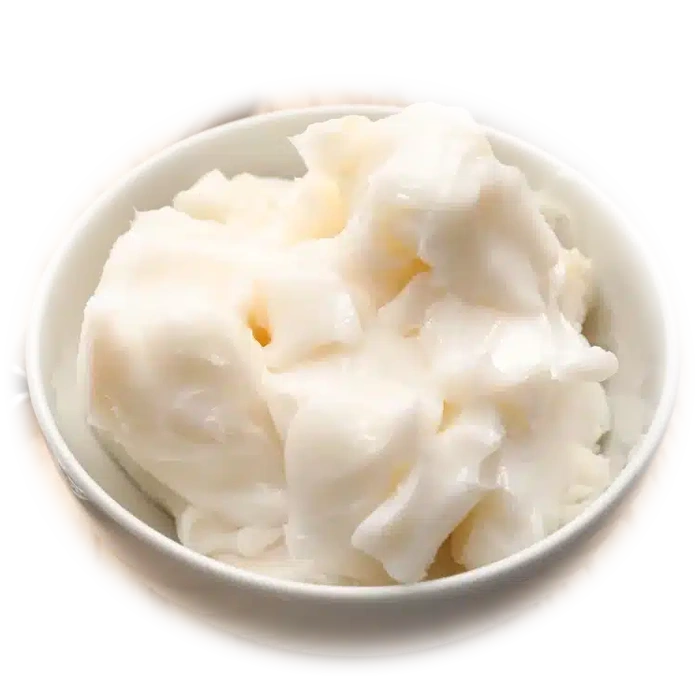
Nutritional properties of Duck fat
Energy :
None Kcal / 100g
Category : Oils and Fats
Group : Animal Fats & Oils
Composition And Nutritional Value :Duck fat is a rich, flavorful animal fat that is rendered from duck meat, particularly from the skin and fatty tissue. It is composed primarily of monounsaturated fats, which are considered heart-healthy, as well as saturated fats and a smaller amount of polyunsaturated fats. One of the distinguishing features of duck fat is its high content of oleic acid, the same monounsaturated fat found in olive oil, which has been linked to reduced bad cholesterol levels. Duck fat also contains omega-3 fatty acids, though in smaller amounts than those found in fatty fish. In addition, it is rich in vitamins like vitamin E and vitamin D, which are essential for maintaining skin health and bone health, respectively.
Health Benefits :
Heart Health: Duck fat is relatively high in monounsaturated fats, which can help to lower bad cholesterol (LDL) levels and improve cardiovascular health. The presence of oleic acid, a healthy fat, makes duck fat a healthier option compared to other animal fats.
Skin Health: Duck fat is a natural source of vitamin E, a potent antioxidant that can help protect the skin from oxidative damage, reducing the signs of aging. The fat’s moisturizing properties also make it a traditional ingredient in skin care products for its ability to hydrate and soften the skin.
Improved Cooking Properties: The high smoke point of duck fat (about 375°F/190°C) makes it an excellent fat for frying and roasting. It can withstand higher cooking temperatures without breaking down, which helps maintain the integrity of nutrients in the food.
Anti-Inflammatory Properties: The omega-3 fatty acids present in duck fat may contribute to anti-inflammatory effects, potentially providing relief from conditions like arthritis and joint pain.
Bone Health: Duck fat contains vitamin D, which is crucial for calcium absorption and promoting strong bones. Vitamin D is also important for maintaining immune function.
Culinary Uses : Duck fat is a prized fat in gourmet cooking due to its rich, savory flavor and versatility. It has been used for centuries in French and other European cuisines, particularly for roasting, frying, and basting meats, especially potatoes. The fat imparts a distinctive taste to dishes, making it a key ingredient in traditional French duck confit and roasted vegetables. Duck fat is particularly popular for frying potatoes, resulting in crispy, golden fries that have a unique depth of flavor. It is also used in the preparation of pâtés and rillettes, enhancing the richness of these dishes. Duck fat can also be used in baking to create flaky, buttery pastries and crusts. In addition, it is sometimes used in salad dressings or marinades to add complexity and richness to the dish.
Types :
Rendered Duck Fat: This is the most common form of duck fat, where the fat is slowly cooked out of the duck meat and strained. It is available in both liquid and solidified forms and is used for cooking and culinary applications.
Duck Fat Oil: A more refined version of rendered duck fat that is often sold as duck fat oil. It is liquid at room temperature and is generally used in frying, roasting, or as a base for sauces.
Flavored Duck Fat: Some chefs and home cooks infuse duck fat with additional herbs and spices to add extra flavor. It can be infused with ingredients like garlic, thyme, or rosemary to create a more aromatic fat for cooking.
Shopping And Storage Tips :
Selecting Duck Fat: When purchasing duck fat, look for high-quality rendered fat that is free from additives or preservatives. If you are buying it from a butcher, ensure that it is fresh and has been properly stored.
Storage: Duck fat should be stored in a cool, dark place, preferably in an airtight container. If you are not using it immediately, it can be kept in the refrigerator for several months. For long-term storage, duck fat can also be frozen.
Shelf Life: When stored properly, duck fat can last up to 6 months in the refrigerator and up to 1 year in the freezer. Make sure to check for any signs of rancidity before use, such as off smells or discoloration.
Usage Tips: Duck fat can be used in place of other cooking fats, such as butter or olive oil, in many recipes. For frying or roasting, duck fat adds a rich flavor, so it’s ideal for dishes like roast potatoes, fried chicken, or duck confit. It’s also perfect for sautéing vegetables or even adding a tablespoon to soups for extra flavor.
Duck fat is a versatile and flavorful fat that offers a healthier alternative to some other animal fats, particularly for cooking. With its rich, savory taste and health benefits, it has gained popularity in both professional kitchens and home cooking.

